January 26, 2022 – Volume 24, Issue 1
In This Issue
- Flanigan’s Eco-Logic: Storage is the Answer
- Lithium-Ion Battery Recycling
- Big American Solar in Indiana
- From Coal Mining to Pumped Hydro Storage
- GAF Energy’s Solar Roof Shingles
- Ubiquitous Energy’s Solar Windows
- Adopt a Charger
- EV Hubs and Battery Swap Stations
- The NetPositive Podcast Updates
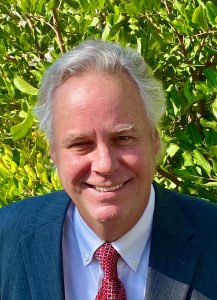
Flanigan’s Eco-Logic: Storage is the Answer
This op-ed is about accelerating solar. Given the climate emergency at hand, and the abundance of free power from above… of course we need to tap solar for our short-term and long-term benefit. The CPUC’s Proposed Decision on net energy metering – see EcoNet News Volume 23 Issue #12 – will retard solar. Is that what we want? No, of course not. This op-ed is about accelerating solar… now smartly with storage.
Without question, here in California we need less power production in the middle of the day. We’re the leading state for distributed solar and we’re awash in mid-day solar thanks to the State’s 1.3 million rooftop solar systems with an aggregate capacity of 10,000 MW. We’ve learned about the duck curve and the perverse effect of so much solar on the grid. When the sun is shining, we have too much of it. Not just rooftop solar… all solar! Huge solar farms in the desert are a big piece of this equation. The solar phenomenon has even shifted our peak period. By 2019, SEIA found that California has 24,700 MW of solar. Much from 771 utility scale plants with a capacity of 14,000 MW.
Let’s recognize the great value that California’s solar policies – the California Solar Initiative (CSI) and Net Energy Metering (NEM) – have provided to California and perhaps one could say the global solar market. The CSI provided a billion dollars of incentives for early adopters to cut the upfront costs of solar. NEM is a major incentive that allows solar to provide great, ongoing financial value, with complete utility back-up. This spawned a new industry of very local jobs. These policies ultimately led to a mandate for all new homes and buildings to be net zero.
And now, yes, solar policy needs to be tweaked. It is certainly time for an upgrade. We now need policies in California and other states that optimize on the benefits and, yes, that minimize the current fault of promoting too much power sloshing onto the grid during the day.
Here’s the deal: If you generate solar on your rooftop during the day right now, it is providing very little value to the grid. You may even be creating a negative value for utilities that have to pay to dump excess power. And you know what makes the situation even worse? Utilities are forced to credit the producer for this near valueless power, and to then give it back to the customer during peak hours at no charge. NEM has understandably become a painful construct for utilities and utility ratepayers.
So what to do? Modify the NEM incentive. Don’t remove it and add penalties. Here’s my proposed plan: You only get to net energy meter if you install solar + storage. Instead of having excess power that has to be dumped, the excess is stored for later use.

California – and later other states – needs to design programs such that utilities can call on the storage when needed for export to the grid. This is really valuable, turning a losing venture into a collaborative success. Now the solar system owner – the great volunteer willing to invest in clean energy – can do so in a way that provides mutual benefit to the consumer, and the grid. The key is requiring storage. Now we can hold that solar power and match it perfectly with our consumption.
Solar has been a rich man’s game. Only the rich can buy, monetize tax credits later, and watch their bill drop to near zero. There has been no equity in this equation and efforts to provide equity are costly and from a resource standpoint, largely ineffective. What to do? I advocate well-designed community solar + storage programs. Build in the desert, tap the economies of scale, and allow all ratepayers the option to invest in solar + storage for economic and environmental reasons.
Two things to amplify: First, and grossly unlike California’s community solar program, the program design has to be simple and valuable. EcoMotion has studied the State’s flawed program extensively. There are much more effective models. Second, the solar has to be paired with storage. It’s the same as rooftop solar: We need to tap the solar resource and to store the valuable carbon free energy for later use.
Longer term, the discussion about solar + storage and creating greater resilience through a network of microgrids, begs a new tariff. Sure, if you invest in solar + storage and can provide resilience to the grid… you deserve to be rewarded. This could happen through a new discounted rate structure for storage accounts (that can export power to the grid) and energy resilience accounts (those that can island). The volunteers that build these systems are providing benefits for themselves and for the grid. Thus rates need to reflect this value.
See how far we are from the Proposed Decision? It aims to make solar much less attractive to the volunteers. Instead, I want to make solar + storage much more attractive. Let’s make it hugely beneficial for volunteers. This is what we need as a society… a logical path forward to promote solar, to accelerate solar… not to penalize a valuable resource as the California Public Utilities Commission has suggested.
Quote of the Week
“What we’ve built is a nail-able solar shingle that goes on as fast or faster than a regular shingle, looks great, and generates electricity.”
Martin DeBono, President, GAF Energy
Lithium-Ion Battery Recycling

Image Courtesy of Redwood Materials
Sony commercialized lithium-ion batteries (LIBs) in 1991. Now lithium-ion batteries are fully embedded in society. They are in home electronics, laptops, cell phones, tablets, power tools, and garden equipment. LIBs also power model aircraft and electric wheelchairs and so much more. They are in aerospace powering the Mars Curiosity Rover. A major use of lithium-ion batteries is for hybrid and electric vehicles.
The booming popularity of electric vehicles (EVs) has resulted in the explosive growth of lithium-ion batteries, and in turn, spent batteries. Industry analysts suggest that China has already generated 500,000 metric tons of used lithium-ion batteries. By 2030, the worldwide amount of spent lithium-ion batteries is projected to be ~2 million metric tons. So far, recycling rates for lithium-ion batteries have been low, 2% in Australia and around 5% in America and Europe. That compares to virtually 100% of the lead acid batteries from cars and trucks that are recycled in the United States.
Here to date, battery researchers have been focused on lowering the costs of new batteries and increasing their longevity. They haven’t been focused on recycling batteries. It’s been a costly and messy proposition: Battery recycling involves high temperature melting and extracting, or smelting,… energy-intensive processes.
But now, fortunately, there is growing interest in this field. There is more academic research and a new breed of engineers coming out to tackle this problem. The U.S. Department of Energy opened its first lithium-ion battery recycling R&D center, the ReCell Center. Its goal is to make lithium-ion battery recycling competitive and profitable. The goal is to use recycled materials instead of continued dependence on foreign sources. The DOE also launched a $5.5 million battery recycling competition.
So let’s dig in: Batteries have four main components: the cathodes, anodes, electrolyte, and separator. Lithium ions are carried by the electrolytes back and forth from cathode to anode.
The materials used to make batteries are responsible for half the battery’s cost. The most common cathode metals, nickel and cobalt, are the most expensive components. Naturally, if recycling processes can be refined and costs lessened, battery recycling could reduce the cost of EVs.
There are a number of benefits of recycling batteries. Less landfill. Less mining and extraction of minerals that are a) scarce and/or b) found in countries that are less than totally stable. While research suggests that reserves of lithium and nickel are sufficient for the growing EV market, battery manufacturing could reduce global cobalt reserves by 10%. And 50% of the world’s cobalt production is in the Democratic Republic of the Congo, tied to armed conflict, illegal mining, human rights abuses, and harmful environmental practices. Lithium and manganese are other LIB metals can be reclaimed at higher concentrations than natural ores… shortening processing.
The battery recycling industry is growing. Companies like Battery Recyclers of America and Global Tech Environmental offer free pickup and payments for 2,000+ pounds of batteries. The chemistries recycled are broad including: lead acid, lithium-ion, lithium iron phosphate, alkaline, button cells, lithium primary, wet and dry nickel cadmium, wet and dry nickel metal hydride, nickel metal hydride, and silver oxide.
Lithium-ion batteries come in all sorts of packaging, making dismantling challenging, and they have varying chemistries. Some lithium-ion batteries use cathodes made of lithium cobalt oxide, others use lithium nickel manganese cobalt oxide, lithium nickel cobalt aluminum oxide, lithium iron phosphate, or other materials. A researcher in Hong Kong noted that the upshot of this is that lithium-ion batteries contain a wide diversity of ever-evolving materials, which makes recycling challenging.
Redwood Materials has raised over $800 million for recycling lithium-ion batteries. The company is headed up by a former Tesla founder and chief technology officer JB Straubel. He left Tesla in 2019 to address what he saw as supply chain constraints tied to lithium-ion batteries. Key to this business is material purification of recycled products. Recently, Panasonic signed a contract with Redwood Materials that will return recycled copper foil back to batteries being assembled at the Tesla Gigafactory. Redwood has also partnered with Ford to help the company with its battery supply chain.
Based in Carson City, Nevada, Redwood Materials plans to expand to locations throughout North America and into Europe. Redwood recycles scrap from battery cell production and consumer electronics like cell phone batteries, laptop computers, power tools, power banks, scooters and electric bicycles. It then processes these goods, extracting cobalt, nickel, and lithium that are typically mined. Redwood then supplies the materials back to customers like Panasonic. Redwood is also working on a program that allows consumers to send in personal electronics such as smart phones for recycling.
Redwood is developing new processes to recycle materials with a focus on car batteries. The challenges include material extraction and purification. Redwoods is proud of the Panasonic deal, as anode copper foil from recycled material is going to the Gigafactory (a $5 billion joint venture between Tesla and Panasonic) and will end up in Tesla vehicles. Thus at least part of the Tesla batteries are going full circle… recycled and returned for use in another new vehicle.
Big American Solar in Indiana
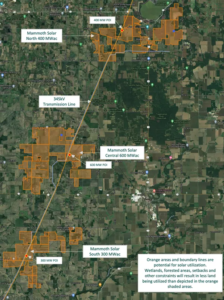
Image Courtesy of Doral Renewables LLC
The Mammoth Solar Farm which is planned to be built in rural Indiana, 80 miles southeast of Chicago, will be 13,000 acres in size. Fully 2,850,000 photovoltaic panels will have a nameplate capacity of 1.65 GW of electricity. The first 400 MW phase of the project is slated to be on line by mid-2023.
The biggest solar farm in the world is the Bhadla Solar Park in India. It covers 14,000 acres and has a nameplate capacity of 2.25 GW. The biggest operating solar farm in America is Solar Star in California, 579 MW (0.58 GW). Mammoth will be three times as big as Solar Star.
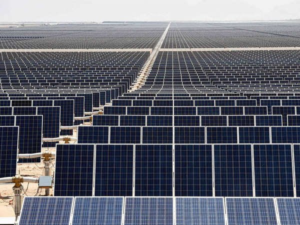
Doral Renewables, an Israeli energy company, is developing the Mammoth project and will sell its output to Ohio-based American Electric Power. Doral owns 400 energy facilities worldwide, with three other projects underway in the United States, two in Pennsylvania and one in Delaware. Doral does not build in particularly sunny areas but claims that “unique geographic characteristics” will yield low-cost power. These include flat land situated on a key grid location, and of course, economies of scale.
From Coal Mining to Pumped Hydro Storage
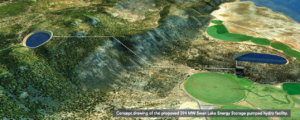
Image (screenshot): Closed loop pumped hydro energy storage project in Oregon courtesy of Rye Development.
One of EcoMotion’s favorite forms of energy storage is pumped hydro storage. But sites are limited, so this caught our eye:
In Bell County, Kentucky, near the Cumberland River, a pumped hydro storage system is being developed, repurposing a former coal strip mine. There, Rye Development plans to build the Lewis Ridge Closed Loop Pumped Hydropower Storage Project. That’s a mouth full! Papers have been filed with Federal Energy Regulatory Commission for 50-years of operation.
Rye Development CEO Paul Jacob is keen on supporting communities that are experiencing coal mine closures with clean energy solutions and jobs. His company is building man-made reservoirs to do the job. The Lewis Ridge project will deliver “family wages” to 2,000 workers during construction and several dozen on a permanent basis.
Here’s how pumped hydro storage works: Water is released from an upper reservoir, and flows down through a penstock to turn hydroelectric turbines that generate electricity during peak periods. Then the water is pumped back up during off-peak periods to repeat the process. The result of this project is 200 MW of power for 8 hours. It’s a $1 billion dollar investment made possible by beneficial topography and proximity to transmission infrastructure.
Boston-based Rye Development has a pipeline of over 25 projects in 10 states, including both new hydropower on existing dams and pumped hydro storage.
GAF Energy’s Solar Roof Shingles
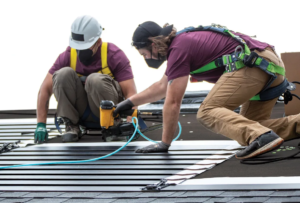 GAF Energy has reportedly installed several thousand integrated solar roofs. That’s more than Tesla Energy roof tiles despite its “ambitious promises.” GAF Energy President Martin DeBono believes his company’s photovoltaic roof shingle positions GAF well to solarize millions of residential roofs. He believes that technology is going to change roofing, that there will be disruption. He compares solar shingles to traditional mounting of solar panels, “solar panels installed on racking secured by drilling through the roof and trying to hit a rafter.”
GAF Energy has reportedly installed several thousand integrated solar roofs. That’s more than Tesla Energy roof tiles despite its “ambitious promises.” GAF Energy President Martin DeBono believes his company’s photovoltaic roof shingle positions GAF well to solarize millions of residential roofs. He believes that technology is going to change roofing, that there will be disruption. He compares solar shingles to traditional mounting of solar panels, “solar panels installed on racking secured by drilling through the roof and trying to hit a rafter.”
The GAF Energy product, in contrast, is installed just like any other shingle would be in order to create a waterproof barrier. It’s nail-able. GAF developed the product “thinking like a roofing company, not a solar company.” It’s a “roofing product that just happens to have solar capabilities.”
The roofing business is 20 times larger than the rooftop solar business. It’s well positioned to get into solar big-time. Last year there were about a half million solar installations in the United States, while more than 5 million new roofs are installed on U.S. homes each year. There’s a huge untapped market out there. GAF commands a 25% share of the U.S. roofing market and thus has the advantage of low customer acquisition costs for solar systems.
GAF Energy’s parent company is Standard Industries, ranked #65 on Forbes’ list of America’s largest private companies. Standard Industries owns both GAF Energy and its sister company GAF, one of the world’s largest roofing companies. GAF manufactures asphalt shingles as well as roofing materials such as thermoplastic polyolefin (TPO), polyvinyl chloride (PVC), and underlayments. Its new 50 megawatt capacity, 112,000 square foot manufacturing facility in San Jose, California is producing the shingles.
Each 45-watt shingle is 60 inches long and 16 inches tall. The shingles use monocrystalline solar cells built to meet roofing product standards. They are designed to be able to be submerged in water, to withstand hail. The shingles also have a Class A fire rating. GAF makes the electrical connections of its shingles easy by placing the electronics and wiring on the top side of its shingles. Roofers install the tiles; GAF comes in later to hook up the strings, combiners, and arrays.
Ubiquitous Energy’s Solar Windows
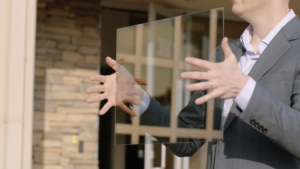
Image Courtesy of Ubiquitous Energy
“We’ll be able to make floor to ceiling glass.… We can turn skyscrapers into vertical solar farms,” said Ubiquitous Energy CEO Susan Stone. Ubiquitous, a start-up, has now received a major investment for the technology from a major window manufacturer. The Andersen Corporation – a leading window and door company, analyzed the technology and notes that while there are competing solar window technologies under development, most have tradeoffs in transparency, color, viewing area obstruction, haze, or energy efficiency… not acceptable to consumers. “They have to look indistinguishable from normal windows,” said Stone.

Image Courtesy of Ubiquitous Energy
Ubiquitous Energy makes a clear coating for windows that uses semiconducting materials to convert sunlight into electricity. The coating is just nanometers thick and tiny wires connect the solar to electrical systems where the energy is used. So far Ubiquitous Energy has raised $70 million for its technology, including a recent $30 million round anchored by Andersen. Ubiquitous Energy anticipates that it will be manufacturing at scale by 2024.
The Ubiquitous Energy windows are ~30% more expensive than traditional windows. While traditional panels are about 22% efficient, the Ubiquitous windows are only 10%. But its developers note that these windows enable a surface that wasn’t generating electricity to do so, creating another productive use… shifting window glass from passive to active.
Adopt a Charger
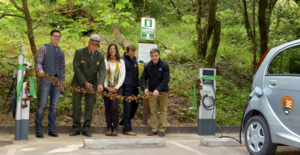
Image: Muir Woods EV Ceremony and Ribbon Cutting courtesy of Adopt a Charger
Adopt a Charger is a Los Angeles based non-profit celebrating 10 years of promoting electric vehicle adoption by expanding U.S. EV infrastructure with free charging. So far, Adopt a Charger has been responsible for installing over 400 chargers in 10 states, including chargers at 26 California State parks and major cultural institutions such as the Getty Center.
Adopt a Charger provides free electric vehicle charging at scenic, cultural, and civic destinations. It operates by matching a sponsor with a popular host site. Recently Adopt A Charger has matched Rivian with Yosemite National Park. As part of the collaboration, Rivian has agreed to pay for the equipment and cover the costs for 10 years of operation. Through the partnership, it has upgraded 13 charging stations at Yosemite to Rivian Waypoints which are all free to the public. They’re at places like the iconic Ahwahnee Hotel. Two charging stations will be installed at Tuolumne Meadows. Dozens more stations are planned with support from Rivian and the Yosemite Conservancy and Yosemite Hospitality.
Adopt a Charger founder and executive director Kitty Adams Hoksbergen noted that, “Since our founding in 2011, Yosemite has been our most requested charging location. I am grateful to Rivian for a commitment that gives visitors the confidence to choose a more climate friendly option when visiting this spectacular park. “ Rivan is also sponsoring free EV charging at the Golden Gate National Recreation Area. Meanwhile, Rivian continues to expand its “Adventure Network” across North America, with plans for over 3,500 DC fast chargers to be installed at 600 sites by 2023.
EV Hubs and Battery Swap Stations
 Oil companies are getting into EV charging in a big way. Shell, the oil giant, has one of the world’s largest networks of fuel stations with over 46,000 retail sites for gasoline and diesel. It also operates a growing network of 8,000 electric charging points and has plans to operate 500,000 charge points by 2025, and 2.5 million by 2030.
Oil companies are getting into EV charging in a big way. Shell, the oil giant, has one of the world’s largest networks of fuel stations with over 46,000 retail sites for gasoline and diesel. It also operates a growing network of 8,000 electric charging points and has plans to operate 500,000 charge points by 2025, and 2.5 million by 2030.
Now, just as it has done in Paris, Shell is converting an existing petrol station in Fulham, central London, to an electric vehicle charging hub that features ten, 175 kW DC fast-charging stations built by Australian manufacturer Tritium. Shell says the chargers will be powered by 100% certified renewable energy. The EV Hub will have solar panels on the roof, and will offer a comfortable seating area for waiting EV drivers, along with a coffee and convenience store.
Many urban dwellers in the United Kingdom, as in other cities worldwide, do not have the option of installing a charger in their home. Many have no assigned parking or have to rely on street parking. As a reporter in the U.K. quipped, charging can be a bit of “a thorny problem.”
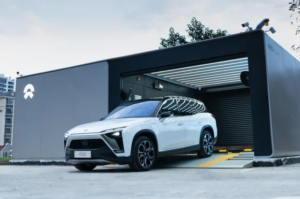
Image Courtesy of NIO
Shell is looking for creative ways of providing EV charging for the “driveway-less masses.” Shell has formed a strategic partnership with Chinese automaker NIO for NIO’s innovative battery swap stations. One hundred swap stations are planned to be installed by 2025. Through the strategic cooperation agreement, the partners intend to jointly construct and operate swapping facilities. So what are these swapping facilities?
Imagine a Jiffy Lube or gas station with a couple of service bays for cars. Nio has developed battery swapping stations for its cars. You drive your Nio to a swap station. It’s automatic: the car parks itself in a station. The car is lifted, a carriage below is used to remove the battery bank; another carriage rolls in carrying a fully charged battery. It is automatically secured, the car lowered, the process complete in less than 5 minutes.
This is certainly a twist on EV charging. The system has the ability to quickly replace a discharged battery with a freshly charged battery. And it’s been tested: NIO reports its 4 millionth EV battery swap since 2018. It now has “fielded” over 500 swap stations, including one in Norway. Stay tuned.
The NetPositive Podcast Updates
Recently Released:
- This issue of EcoNet News, Volume 24, Issue #1 is also available in podcast format
- The Net Positive Podcast: A Conversation on Social and Environmental Justice, Diversity in Architecture, and Sustainable Building Design with Steve Lewis, Principal, ZGF Architects
- The NetPositive Crash Course on Electric Vehicles with Ted Flanigan, hosted by Sierra Flanigan

Check out and subscribe to The NetPositive Podcast with Ted Flanigan on Spotify, Apple, and Google. Episodes include Convos (Conservations and Crash Courses), the News (EcoNet News), and Uni (the EcoMotion University).
